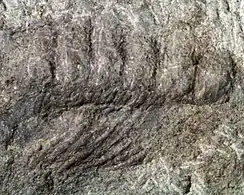Pneumodesmus
Pneumodesmus newmani is a species of myriapod that lived in the Paleozoic. Its exact age is uncertain; it was originally interpreted as living 428 million years ago, in the Late Silurian;[1][2] however, the study conducted by Suarez et al. (2017) indicates that it actually lived in the Early Devonian (Lochkovian).[3] It is one of the first myriapods, and among the oldest creatures to have lived on land[4] It was discovered in 2004, and is known from a single specimen from Stonehaven, Aberdeenshire, Scotland.[2]
| Pneumodesmus | |
|---|---|
 | |
| Reconstruction of Pneumodesmus newmani | |
| Scientific classification | |
| Kingdom: | |
| Phylum: | |
| Subphylum: | |
| Class: | |
| Subclass: | |
| Order: | |
| Family: | |
| Genus: | Pneumodesmus |
| Species: | P. newmani |
| Binomial name | |
| Pneumodesmus newmani Wilson & Anderson, 2004 [1] | |

Discovery and naming
The fossil of P. newmani was found by Mike Newman, a bus driver and amateur palaeontologist from Aberdeen, in a layer of sandstone rocks on the foreshore of Cowie, near Stonehaven.[5] The species was later given the specific epithet "newmani" in honour of Newman. The holotype is kept in National Museum of Scotland, Edinburgh.[6] The genus name is said to derived from the Greek pneumato, meaning "air" or "breath",[1] in reference to the inferred air-breathing habit.[1] The proper word in ancient Greek for "air" or "breath" is however pneuma (πνεῦμα).[7]
Description
The single, 1 cm-long fragment of P. newmani depicts small paranota (keels) high on the body, long, slender legs. There are siz body segments preserved, and the dorsal portion of each segment is ornamented with a horizontal bar and three rows of roughly hexagonal bosses (bumps).[1] Myriapods are the group that include millipedes and centipedes, and Pneumodesmus newmani would have resembled a millipede in appearance. However it did not belong to the same branch of myriapods as modern millipedes.
Significance
The fossil is important because its cuticle contains openings which are interpreted as spiracles, part of a gas exchange system that would only work in air. This makes P. newmani the earliest documented arthropod with a tracheal system, and among the first known oxygen-breathing animal on land.[4][8]
Trace fossils of myriapods are known dating back to the late Ordovician[1] (the geologic period preceding the Silurian), but P. newmani is the earliest body fossil of a myriapod, and has been dated to between 428 million years ago (Silurian, late Wenlock epoch to early Ludlow epoch) and 414 million years ago (Early Devonian (Lochkovian)).[3] There are also trigonotarbid and arachnid fossils dating to around this time known from Lludlow in Shropshire, and together these comprise the oldest known air-breathing terrestrial animals.[6] The earliest centipedes follow some 10 million years later,[8] and the first known vertebrate on land, Tiktaalik, dates from 50 million years later than Pneumodesmus.[9]
During the Silurian, the rocks that would later be part of Scotland were being laid down on the continent of Laurentia, in a tropical part of the Southern Hemisphere.[10]
References
- Heather M. Wilson & Lyall I. Anderson (2004). "Morphology and taxonomy of Paleozoic millipedes (Diplopoda: Chilognatha: Archipolypoda) from Scotland". Journal of Paleontology. 78 (1): 169–184. doi:10.1666/0022-3360(2004)078<0169:MATOPM>2.0.CO;2.
- "Fossil find 'oldest land animal'". BBC News. January 25, 2004.
- Stephanie E. Suarez; Michael E. Brookfield; Elizabeth J. Catlos; Daniel F. Stöckli (2017). "A U-Pb zircon age constraint on the oldest-recorded air-breathing land animal". PLoS ONE. 12 (6): e0179262. doi:10.1371/journal.pone.0179262. PMC 5489152. PMID 28658320.
- "Fossil millipede found to be oldest land creature". CNN (from Reuters). January 27, 2004.
- "Pneumodesmus newmani Exhibition". Stonehaven Guide. Archived from the original on December 24, 2016. Retrieved Oct 22, 2013.
- Paul Selden & Helen Read (2008). "The oldest land animals: Silurian millipedes from Scotland" (PDF). Bulletin of the British Myriapod & Isopod Group. 23: 36–37.
- Liddell, H.G. & Scott, R. (1940). A Greek-English Lexicon. Revised and augmented throughout by Sir Henry Stuart Jones. With the assistance of Roderick McKenzie. Oxford: Clarendon Press.
- Rowland Shelley & Paul Marek (March 1, 2005). "Millipede Fossils". East Carolina University. Archived from the original on May 27, 2011.
- David Winter (April 9, 2006). "When animals first conquered the land". Science and sensibility.
- "Cowie". BBC Scotland. Retrieved May 6, 2007.